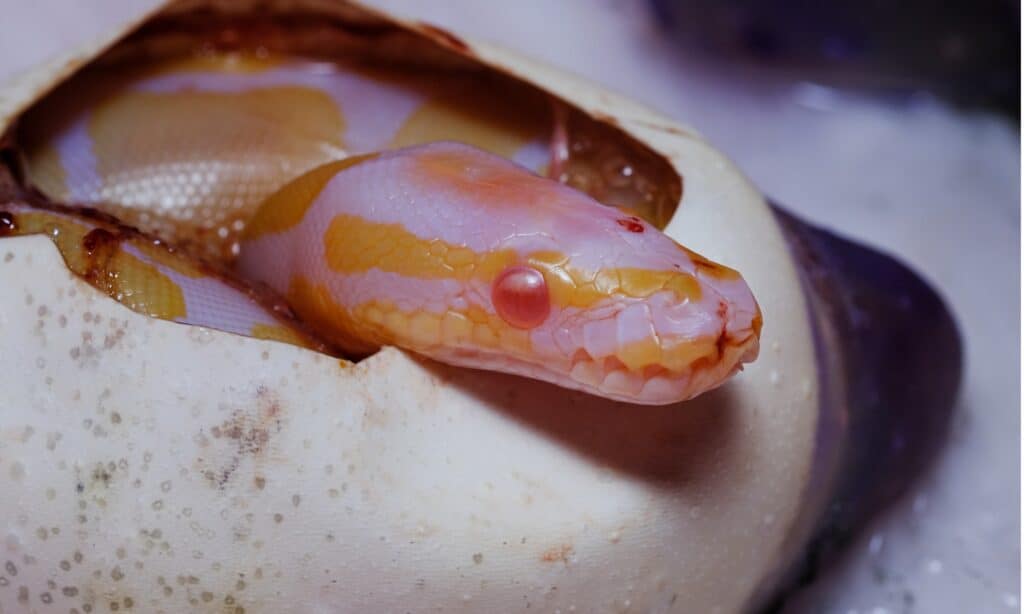Lavender Albino Ball Python
Python regius
The first two lavender albino ball pythons were wild-hatched and imported from Africa.
Advertisement
Lavender Albino Ball Python Scientific Classification
- Kingdom
- Animalia
- Phylum
- Chordata
- Class
- Reptilia
- Order
- Squamata
- Family
- Pythonidae
- Genus
- Python
- Scientific Name
- Python regius
Read our Complete Guide to Classification of Animals.
Lavender Albino Ball Python Conservation Status
Lavender Albino Ball Python Facts
- Prey
- Small rodents, nestling birds
- Main Prey
- Small rodents like rats and mice.
- Name Of Young
- Hatchling
- Group Behavior
- Solitary except during mating season
- Fun Fact
- The first two lavender albino ball pythons were wild-hatched and imported from Africa.
- Most Distinctive Feature
- lavender base color with high-contrast, bright yellow markings
- Lifestyle
- Nocturnal/Crepuscular
- Favorite Food
- Rodents
- Origin
- Western Africa
- Group
- knot, nest
Lavender Albino Ball Python Physical Characteristics
- Color
- Yellow
- Blue
- White
- Albino
- Orange
- Purple
- Pink
- Skin Type
- Scales
- Lifespan
- 30+ years
- Length
- 4-6 feet
- Age of Sexual Maturity
- 3-4 years
- Venomous
- No
- Aggression
- Low
View all of the Lavender Albino Ball Python images!
Lavender albino ball pythons carry a recessive gene that eliminates all the dark colors from their patterns and gives them a lavender or baby blue base color.
Ball pythons are one of the most commonly traded pet snakes worldwide. Since 1975, more than 3 million ball pythons have been exported from their habitat in Central and Western Africa.
Incredible Lavender Albino Ball Python Facts
- Lavender albino is a recessive color mutation. The name comes from their base color, which is lavender or baby blue instead of the white of typical albino ball pythons.
- Albino animals are more sensitive to the sun because they lack the pigment of darker animals.
- They were originally bred from two wild-hatched snakes imported from Africa.
Lavender Albino Ball Python Scientific Name and Classification
Lavender albino ball pythons are a different color pattern than other ball pythons, but they’re still ball pythons. It’s like the difference between a sable German Shepherd and a black and tan German Shepherd. They’re essentially the same dog, but different colors. Some colors can be linked to genetic problems, but most of the time, it’s just a color change.
All ball pythons are members of the Pythonidae family, and their scientific name is Python regius. The Latin root of regius means of or pertaining to a king, kingly, regal, or royal. Their “ball python” common name comes from their tendency to coil up into a ball when they get nervous.
Lavender Albino Ball Python Appearance and Behavior
Lavender ball pythons are constrictors that subdue their prey by squeezing it until the heart stops before swallowing it whole. They have the normal ball python body – strong and muscular with a classic triangle-shaped head with a blunt nose. They measure 4-6 feet long, and the females are bigger than the males. Like other pythons, these snakes have heat-sensitive pits that line their upper lip and help them locate prey, even in the dark.
Lavender Albino Ball Python Morph
These snakes lack all of the dark pigmentations of a normal ball python, leaving a high-contrast color pattern. As hatchlings, the lavender is very pale, but it becomes more pronounced as the babies grow. The areas that are white in a normal albino have a beautiful lavender or baby blue color and the patterned areas are bright yellow to orange, sometimes outlined in pumpkin orange. Their eyes are also different from other albinos, and instead of the pale pink you expect in an albino, the lavender albino ball python has ruby-red eyes.
This ball python color morph is easy to care for, as are most ball python morphs. They don’t have the head wobble of those with the spider gene. However, as albinos, they are much more sensitive to light.
With patience, these snakes can be just as easy-going as other morphs. They make a beautiful addition to any reptile collection.

Lavender albino ball pythons are albinos, except that they have a purplish-bluish hue to their skin that deepens over time.
©iStock.com/Suriyapong Koktong
Lavender Albino Ball Python Habitat and Diet
Wild ball pythons inhabit open grasslands, forests, and cultivated areas in central and western Africa. They occur in Guinea-Bissau, Guinea, Senegal, Sierra Leone, Cote d’Ivoire, Mali, Burkina Faso, Ghana, Togo, Benin, Niger, Nigeria, Cameroon, Chad, DR Congo, Central African Republic, and South Sudan. The bronze/brown “alien head” markings along their sides and dark base color help them blend in effectively to their environment.
Now, getting to the albino animals. They do happen in nature, but they’re rare. They are also at a strategic disadvantage because they can’t blend into their habitat. It makes them an easy target for predators. So, even when they do occur, they often don’t survive. The few that have been found in the wild over the years are the exception, not the rule.
Lavender albino ball pythons are only different on the outside, their dietary needs are the same as any other ball python. They eat rodents and small warm-blooded animals that they can overpower and fit down their throats.
Lavender Albino Ball Python Predators, Threats, Conservation, and Population
According to the IUCN Redlist of Threatened Species, ball pythons in the wild are classified as “Near Threatened.” While they’re still relatively common in West Africa, reports of declining populations seem to be increasing. They’re poached for meat, leather, and for use in traditional medicine. They are also threatened by agricultural expansion and other forms of habitat destruction.
However, lavender albino ball pythons are primarily captive-bred. Their numbers, at least, are stable and probably growing as they’re included in many ball python morphs.
Lavender Albino Ball Python Reproduction, Babies, and Lifespan
Lavender albino ball pythons are a popular color morph of the ball python. Ralph Davis had accepted a female import from Africa that was originally offered as a normal female albino ball python. He kept this one hidden for a few years, until a few years later when he and NERD stumbled across another import, also offered as an albino – this one a male. The two were bred together in 2001 and four babies hatched out exactly like the parents – lavender albinos.
Humans and ball pythons share the same genes responsible for albinism. In ball pythons, these genes are responsible for lavender albino, toffee, albino, and candy. The lavender albino trait is caused by a deletion of the OCA2 gene. This gene is responsible for encoding a protein that controls the pH of the melanosome – where melanin is produced.
Like other ball pythons, lavender albino ball pythons are egg layers and mature after about 3-4 years. They can lay up to about 10 eggs, around which they coil until the eggs hatch.
Similar Animals
View all 98 animals that start with LLavender Albino Ball Python FAQs (Frequently Asked Questions)
Are lavender albino ball pythons aggressive?
No, like other ball pythons, they can be just as relaxed. They’re beautiful color morphs that do well as pets.
What do lavender albino ball pythons eat?
They’re ball pythons, so they take rats and mice in captivity.
Where can you get a lavender ball python?
Since the original four were bred in 2001, many other breeders have begun producing morphs that include the lavender albino gene.
Are lavender albino ball pythons venomous?
No! These are nonvenomous constrictors. Lavender albino ball pythons are just a different color of ball python.
Thank you for reading! Have some feedback for us? Contact the AZ Animals editorial team.
Sources
- Lavender Albino Ball Python, Ralph Davis Reptiles / Accessed August 19, 2022
- D'Cruze, N., Wilms, T., Penner, J., Luiselli, L., Jallow, M., Segniagbeto, G., Niagate, B. & Schmitz, A. 2021. Python regius. The IUCN Red List of Threatened Species 2021: e.T177562A15340592. https://dx.doi.org/10.2305/IUCN.UK.2021-2.RLTS.T177562A15340592.en. Accessed on 19 August 2022. / Published July 16, 2012 / Accessed August 19, 2022
- Morph Market / Accessed August 19, 2022


















